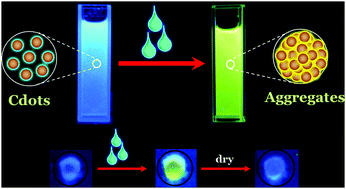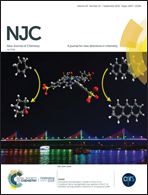Aggregation-induced red shift in N,S-doped chiral carbon dot emissions for moisture sensing†
Abstract
Being a promising class of carbogenic nanomaterials with excellent photophysical and photochemical properties, carbon dots (Cdots) have been exploited for multifaceted applications to date. Herein, a facile synthetic approach has been utilized in order to prepare Cdots using the microwave method, which demonstrates the production of crystalline Cdots unifying exceptional properties such as chirality, solvatochromism, and aggregation-induced emission (AIE) with a red shift and a high quantum yield. Our study on the aggregation behaviors of Cdots revealed the coexistence of complex aggregates in our system. AIE induced luminescence color change of the Cdots is demonstrated with the help of chromaticity color coordinates in the CIE diagram and the hue spectrum/histogram using a smartphone. The pronounced AIE effects of Cdots lead to the detection of moisture in various solvents e.g. acetone, acetonitrile, ethanol, THF, DMSO, methanol, and formamide. Remarkably, Cdots are highly responsive for water in acetone solvent with the LOD as low as 8.47 ppm. Furthermore, the Cdots were successfully employed for the detection and quantitative determination of the moisture content in daily used commercial products and drugs. Then, a gel (or fluorescent ink) was also fabricated on a non-fluorescent paper that behaves as a molecular switch showing the reusability of Cdots as moisture sensors for practical applications.



 Please wait while we load your content...
Please wait while we load your content...